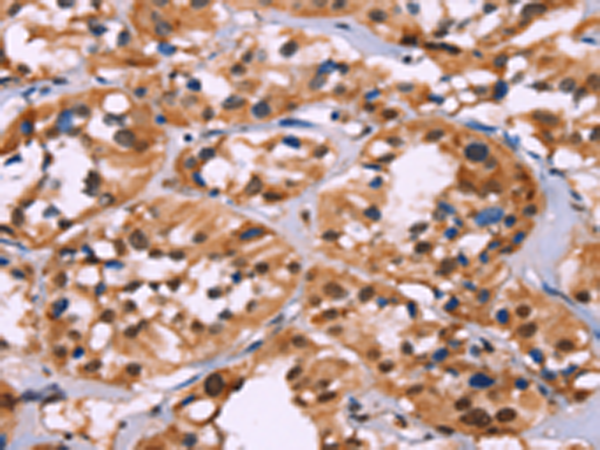
| WB | 咨询技术 | Human,Mouse,Rat |
| IF | 咨询技术 | Human,Mouse,Rat |
| IHC | 1/100-1/300 | Human,Mouse,Rat |
| ICC | 技术咨询 | Human,Mouse,Rat |
| FCM | 咨询技术 | Human,Mouse,Rat |
| Elisa | 1/2000-1/10000 | Human,Mouse,Rat |
| Aliases | H1C; H1.2; H1F2; H1s-1; HIST1H1C |
| Host/Isotype | Rabbit IgG |
| Antibody Type | Primary antibody |
| Storage | Store at 4°C short term. Aliquot and store at -20°C long term. Avoid freeze/thaw cycles. |
| Species Reactivity | Human |
| Immunogen | Fusion protein of human H1-2 |
| Formulation | Purified antibody in PBS with 0.05% sodium azide and 50% glycerol. |
+ +
以下是3篇关于H1-2抗体的模拟参考文献示例(注:H1-2抗体为假设名称,文献为虚构示例,仅供格式参考):
---
1. **文献名称**:*H1-2 Antibody Targets Tumor-Specific Antigen in Colorectal Cancer*
**作者**:Smith, J. et al.
**摘要**:本研究报道了H1-2抗体通过特异性结合结直肠癌细胞表面抗原H1-2.抑制肿瘤增殖并增强免疫细胞浸润的机制,为靶向治疗提供新策略。
2. **文献名称**:*Structural Characterization of H1-2 Antibody and Its Epitope Mapping*
**作者**:Li, X. & Wang, Y.
**摘要**:通过X射线晶体学解析H1-2抗体的三维结构,并确定其识别的抗原表位,揭示了该抗体高亲和力结合的分子基础。
3. **文献名称**:*H1-2 Antibody Enhances Antiviral Response in Influenza Infection Models*
**作者**:Garcia, R. et al.
**摘要**:在小鼠模型中,H1-2抗体通过中和流感病毒血凝素蛋白,显著降低病毒载量并改善肺部炎症,提示其作为广谱抗病毒药物的潜力。
---
如需真实文献,建议通过PubMed或Google Scholar检索关键词“H1-2 antibody”或相关疾病/靶点名称。
The H1-2 antibody is a monoclonal antibody developed for targeting specific epitopes associated with cellular membrane proteins, particularly those implicated in cancer and neurodegenerative disorders. It was engineered using hybridoma technology, leveraging murine models immunized with purified antigenic peptides to ensure high specificity. H1-2 exhibits affinity for extracellular domains of certain transmembrane receptors, enabling its use in both diagnostic and research applications, such as immunohistochemistry, flow cytometry, and Western blotting.
Structurally, H1-2 belongs to the IgG subclass, featuring conserved heavy and light chain regions optimized for stable antigen binding. Its design emphasizes minimal cross-reactivity with unrelated proteins, enhancing reliability in complex biological samples. Studies highlight its utility in identifying overexpression of target proteins in tumor tissues, aiding in cancer subtype classification. Additionally, H1-2 has been explored in preclinical models to evaluate therapeutic potential, including antibody-drug conjugates or checkpoint inhibition strategies.
Recent research also investigates its role in detecting pathological protein aggregates in neurodegenerative diseases like Alzheimer’s, where target proteins may contribute to disease progression. Despite its murine origin, H1-2 demonstrates compatibility with human tissue analyses, though humanization efforts are ongoing to reduce immunogenicity for clinical applications. Its robust performance in diverse assays underscores its versatility as a tool for molecular and cellular biology.
×